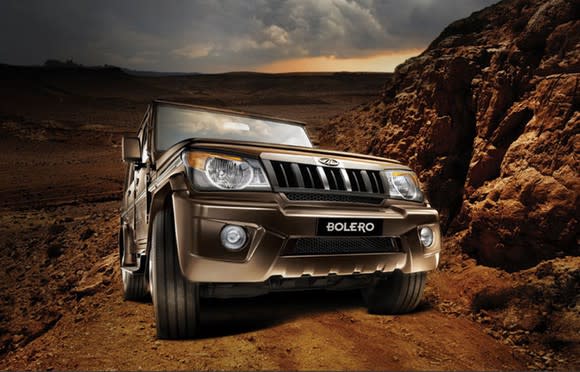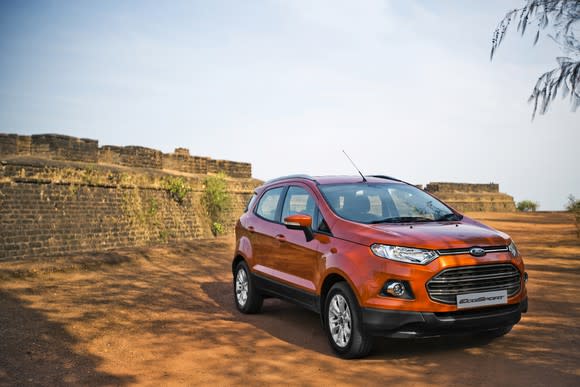Why Ford and Mahindra Are Teaming Up on SUVs and EVs for India
Ford Motor Company (NYSE: F) and Indian automaker Mahindra & Mahindra Ltd. (NASDAQOTH: MAHMF) have agreed to work together to develop two new SUVs and an electric vehicle.
The deal, announced on Thursday, builds on a strategic alliance between Ford and Mahindra that began last year. It's a step forward for CEO Jim Hackett's effort to rethink and expand Ford's presence in India.
The deal: New SUVs for India, and an electric vehicle too
In a joint statement, Ford and Mahindra said that they had signed a total of five new memoranda of understanding to "accelerate the development of key products for consumers in India and emerging markets." Among those key products:
A new midsize SUV will be developed jointly on an existing Mahindra platform. Ford and Mahindra will each have a version of the SUV, and will market them separately.
The two will evaluate co-development of a new compact SUV and an electric vehicle of some kind.
Ford and Mahindra may also share powertrains (engines and transmissions). One possibility: Ford may buy low-cost powertrains from Mahindra to use in new products for the Indian market.
The two will also work together to develop a suite of connected-car solutions, as part of Ford's global effort to build connectivity into more of its vehicles.
The companies didn't give details on the timing of these new products.
What Mahindra gets: Access to Ford's expertise
Mahindra is one of India's industrial giants. It's a big builder of farm equipment and vehicles of all kinds, and it has been the country's leading seller of SUVs for years. The simple and rugged Mahindra Bolero SUV is among the country's best-selling vehicles. The company's products are simple, rugged, and affordable -- but by global automaking standards, they're kind of rough around the edges. (That's not a criticism. They're successful in their intended market.)

The rugged Mahindra Bolero is a popular SUV in India. Image source: Mahindra & Mahindra Ltd.
What Mahindra gets from working with Ford is access to the kind of technology and expertise that can help take it to the next level. Among other things, Mahindra has been working on the challenge of developing an electric vehicle that could be sold profitably to India's exceptionally cost-conscious consumers.
"We are excited about the synergies unveiled through this collaboration and the potential opportunities it will bring," said Dr. Pawan Goenka, Mahindra's managing director.
What Ford gets: Another chance to grow in India
Ford global markets chief Jim Farley said that the deal will boost two of Ford's current areas of focus, SUVs and electric vehicles:
Ford is committed to offering the best vehicles, technologies and services that fit the lifestyles and preferences of Indian consumers. Listening to our customers and incorporating their future needs is the core premise of this collaboration. With utility vehicles and electrification as key focus areas, we are glad to see the progress our two companies have made.
It's also a way to boost Ford's presence in India, where the company has had decidedly mixed success since ramping up its investments early in the decade.

Ford originally developed the little EcoSport SUV for emerging markets like India. But it's had more success exporting it from India to the U.S. and Europe. Image source: Ford Motor Company.
Ford began building two factories in India in 2010, in anticipation of sales growth that didn't materialize. It shifted to an export strategy in 2013, using those factories as low-cost production centers while it waited for local demand for Fords to increase.
It's still building vehicles for export, notably the new EcoSport, which is built in India for the U.S. and European markets. But Fords still haven't caught on in a big way with Indian consumers, who are among the world's most price-conscious when it comes to car-shopping.
Hackett and Farley clearly think that Ford could be a bigger player in India if it had lower-cost products that it could build and sell profitably. That's probably true, and sharing product-development costs with Mahindra is a path that seems to stand a good chance of success.
More From The Motley Fool
John Rosevear owns shares of Ford. The Motley Fool owns shares of and recommends Ford. The Motley Fool has a disclosure policy.

 Yahoo Finance
Yahoo Finance 